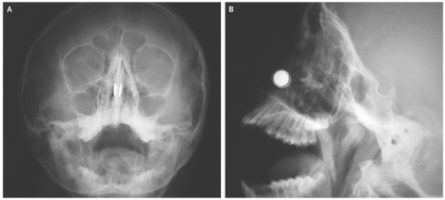- Home
- Editorial
- News
- Practice Guidelines
- Anesthesiology Guidelines
- Cancer Guidelines
- Cardiac Sciences Guidelines
- Critical Care Guidelines
- Dentistry Guidelines
- Dermatology Guidelines
- Diabetes and Endo Guidelines
- Diagnostics Guidelines
- ENT Guidelines
- Featured Practice Guidelines
- Gastroenterology Guidelines
- Geriatrics Guidelines
- Medicine Guidelines
- Nephrology Guidelines
- Neurosciences Guidelines
- Obs and Gynae Guidelines
- Ophthalmology Guidelines
- Orthopaedics Guidelines
- Paediatrics Guidelines
- Psychiatry Guidelines
- Pulmonology Guidelines
- Radiology Guidelines
- Surgery Guidelines
- Urology Guidelines
Button Magnets in the Nasal Cavity

Magnets like any other small objects can be dangerous toys for children which if swallowed can lead to a medical emergency. In a recent case of an 11-year-old boy in Cyprus didn't swallow the magnets but instead inserted two flat, circular magnets into his nostrils.The magnets, one of which was in each nostril, were drawn together, and the boy was unable to remove them, according to the case report, published today in The New England Journal of Medicine.
An 11-year-old boy was brought to the emergency department 6 hours after he had inserted button magnets on both sides of his nose. He had been unable to remove the magnets and presented with epistaxis and severe pain. Examination of the nasal cavity showed mucus and crusted blood.
Radiography of the face revealed two disk-shaped foreign bodies at the same level across the nasal septum. Attracting nasal magnets necessitate emergency removal because they can compress the mucosa of the nasal septum, leading to necrosis and septal perforation.
Attempts to remove the magnets in the emergency department were unsuccessful because of intense adherence, and the patient was taken to the operating room for removal of the magnets while he was under general anesthesia. The magnets were elevated off the nasal septum with the help of household magnets that were placed externally on both sides of the nose. The magnets had caused compression and mucoperichondrial erosion of the septal cartilage. Adhesion barriers were placed over the traumatized tissue surfaces, and splints were applied for 10 days. It was found in follow-up 6 months later that the previously exposed cartilage was covered by healthy nasal mucosa.
For more details click on the link :

Disclaimer: This site is primarily intended for healthcare professionals. Any content/information on this website does not replace the advice of medical and/or health professionals and should not be construed as medical/diagnostic advice/endorsement or prescription. Use of this site is subject to our terms of use, privacy policy, advertisement policy. © 2020 Minerva Medical Treatment Pvt Ltd